Hospitality Management
VerifiedAdded on 2023/04/11
|9
|1529
|465
AI Summary
This paper presents a positional analysis of J.W Mariott in the hospitality industry using PESTLE and Porter's Five Forces analysis. It explores the company background, current market situation, and provides recommendations for improvement.
Contribute Materials
Your contribution can guide someone’s learning journey. Share your
documents today.
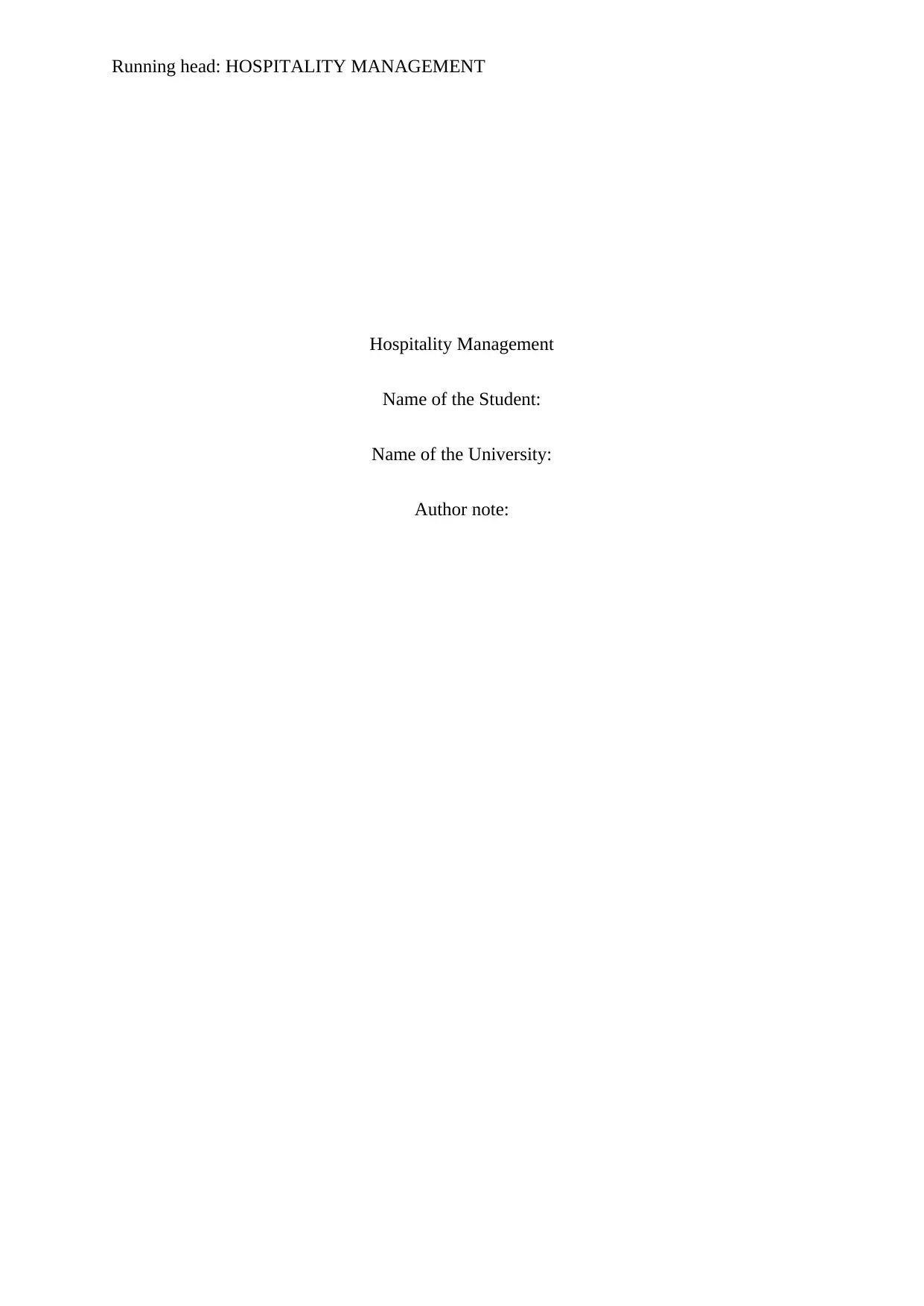
Running head: HOSPITALITY MANAGEMENT
Hospitality Management
Name of the Student:
Name of the University:
Author note:
Hospitality Management
Name of the Student:
Name of the University:
Author note:
Secure Best Marks with AI Grader
Need help grading? Try our AI Grader for instant feedback on your assignments.
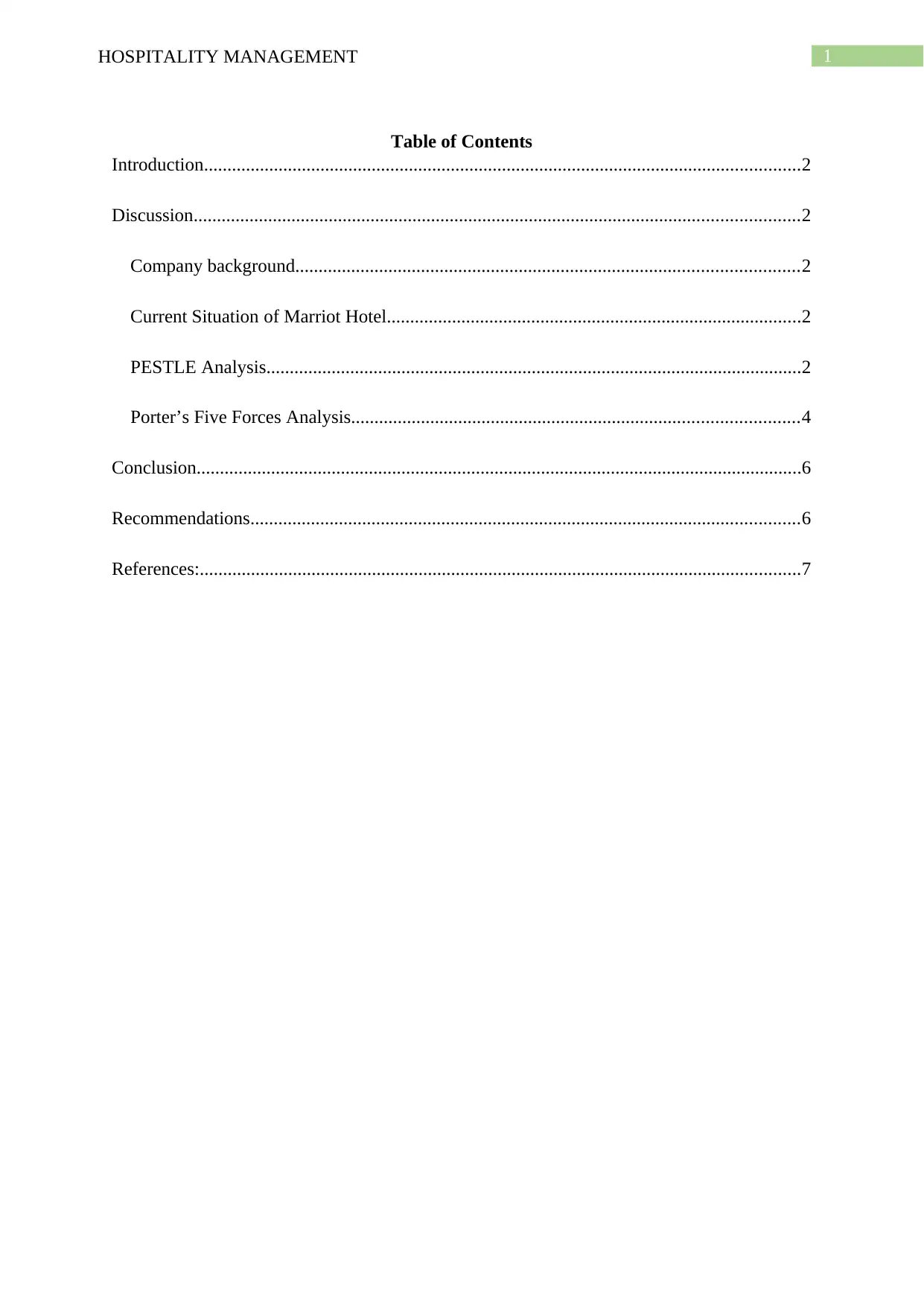
1HOSPITALITY MANAGEMENT
Table of Contents
Introduction................................................................................................................................2
Discussion..................................................................................................................................2
Company background............................................................................................................2
Current Situation of Marriot Hotel.........................................................................................2
PESTLE Analysis...................................................................................................................2
Porter’s Five Forces Analysis................................................................................................4
Conclusion..................................................................................................................................6
Recommendations......................................................................................................................6
References:.................................................................................................................................7
Table of Contents
Introduction................................................................................................................................2
Discussion..................................................................................................................................2
Company background............................................................................................................2
Current Situation of Marriot Hotel.........................................................................................2
PESTLE Analysis...................................................................................................................2
Porter’s Five Forces Analysis................................................................................................4
Conclusion..................................................................................................................................6
Recommendations......................................................................................................................6
References:.................................................................................................................................7
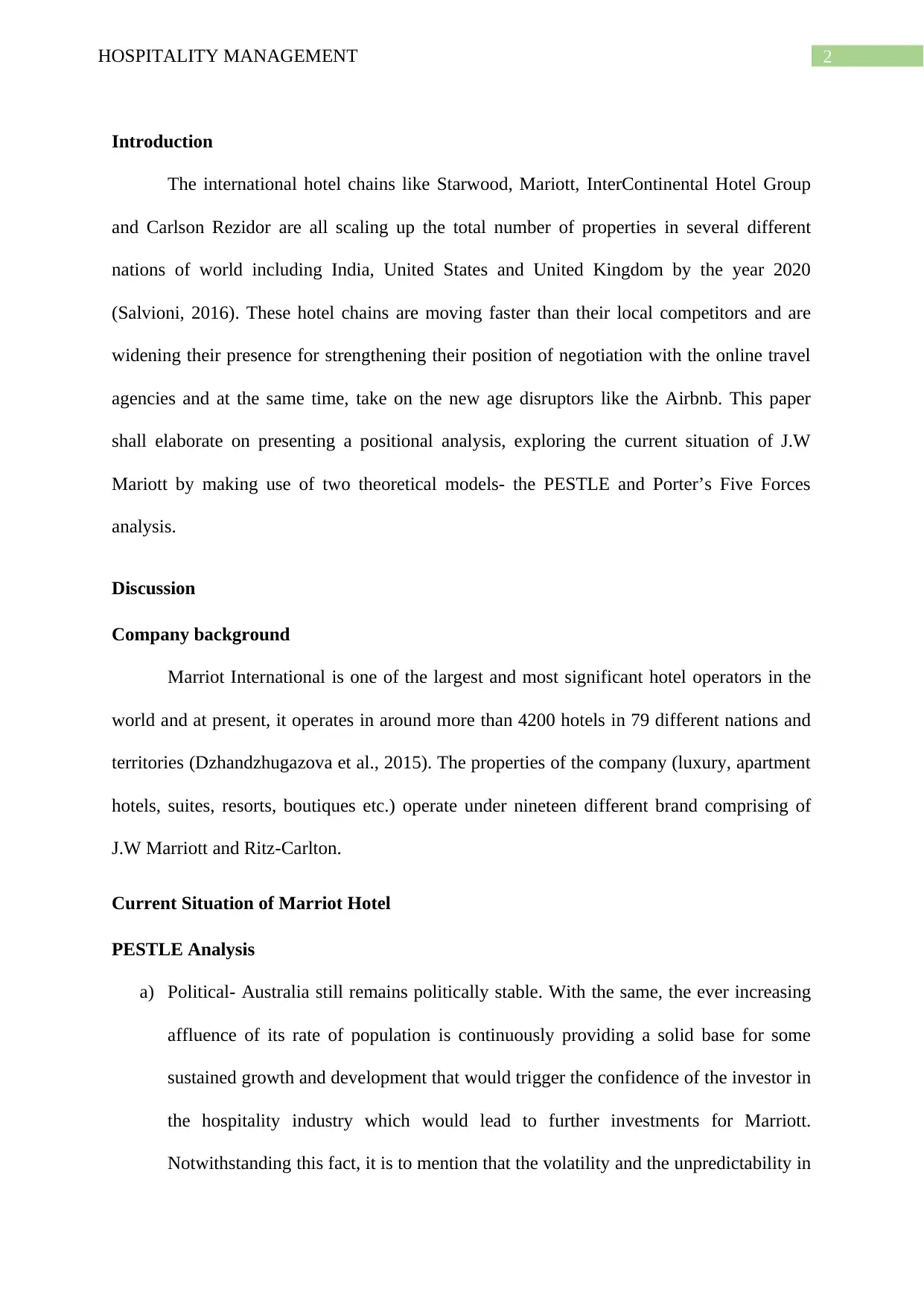
2HOSPITALITY MANAGEMENT
Introduction
The international hotel chains like Starwood, Mariott, InterContinental Hotel Group
and Carlson Rezidor are all scaling up the total number of properties in several different
nations of world including India, United States and United Kingdom by the year 2020
(Salvioni, 2016). These hotel chains are moving faster than their local competitors and are
widening their presence for strengthening their position of negotiation with the online travel
agencies and at the same time, take on the new age disruptors like the Airbnb. This paper
shall elaborate on presenting a positional analysis, exploring the current situation of J.W
Mariott by making use of two theoretical models- the PESTLE and Porter’s Five Forces
analysis.
Discussion
Company background
Marriot International is one of the largest and most significant hotel operators in the
world and at present, it operates in around more than 4200 hotels in 79 different nations and
territories (Dzhandzhugazova et al., 2015). The properties of the company (luxury, apartment
hotels, suites, resorts, boutiques etc.) operate under nineteen different brand comprising of
J.W Marriott and Ritz-Carlton.
Current Situation of Marriot Hotel
PESTLE Analysis
a) Political- Australia still remains politically stable. With the same, the ever increasing
affluence of its rate of population is continuously providing a solid base for some
sustained growth and development that would trigger the confidence of the investor in
the hospitality industry which would lead to further investments for Marriott.
Notwithstanding this fact, it is to mention that the volatility and the unpredictability in
Introduction
The international hotel chains like Starwood, Mariott, InterContinental Hotel Group
and Carlson Rezidor are all scaling up the total number of properties in several different
nations of world including India, United States and United Kingdom by the year 2020
(Salvioni, 2016). These hotel chains are moving faster than their local competitors and are
widening their presence for strengthening their position of negotiation with the online travel
agencies and at the same time, take on the new age disruptors like the Airbnb. This paper
shall elaborate on presenting a positional analysis, exploring the current situation of J.W
Mariott by making use of two theoretical models- the PESTLE and Porter’s Five Forces
analysis.
Discussion
Company background
Marriot International is one of the largest and most significant hotel operators in the
world and at present, it operates in around more than 4200 hotels in 79 different nations and
territories (Dzhandzhugazova et al., 2015). The properties of the company (luxury, apartment
hotels, suites, resorts, boutiques etc.) operate under nineteen different brand comprising of
J.W Marriott and Ritz-Carlton.
Current Situation of Marriot Hotel
PESTLE Analysis
a) Political- Australia still remains politically stable. With the same, the ever increasing
affluence of its rate of population is continuously providing a solid base for some
sustained growth and development that would trigger the confidence of the investor in
the hospitality industry which would lead to further investments for Marriott.
Notwithstanding this fact, it is to mention that the volatility and the unpredictability in
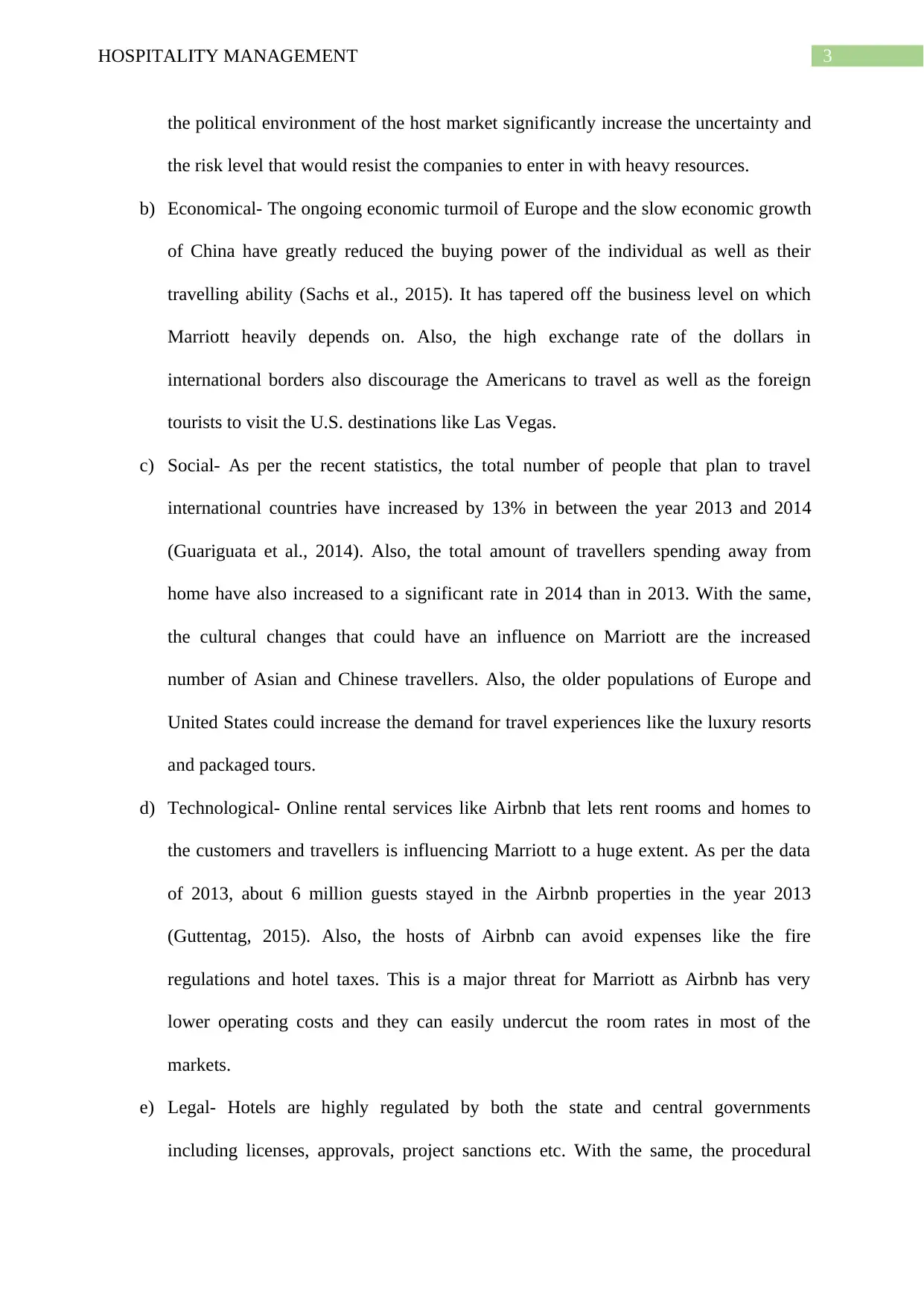
3HOSPITALITY MANAGEMENT
the political environment of the host market significantly increase the uncertainty and
the risk level that would resist the companies to enter in with heavy resources.
b) Economical- The ongoing economic turmoil of Europe and the slow economic growth
of China have greatly reduced the buying power of the individual as well as their
travelling ability (Sachs et al., 2015). It has tapered off the business level on which
Marriott heavily depends on. Also, the high exchange rate of the dollars in
international borders also discourage the Americans to travel as well as the foreign
tourists to visit the U.S. destinations like Las Vegas.
c) Social- As per the recent statistics, the total number of people that plan to travel
international countries have increased by 13% in between the year 2013 and 2014
(Guariguata et al., 2014). Also, the total amount of travellers spending away from
home have also increased to a significant rate in 2014 than in 2013. With the same,
the cultural changes that could have an influence on Marriott are the increased
number of Asian and Chinese travellers. Also, the older populations of Europe and
United States could increase the demand for travel experiences like the luxury resorts
and packaged tours.
d) Technological- Online rental services like Airbnb that lets rent rooms and homes to
the customers and travellers is influencing Marriott to a huge extent. As per the data
of 2013, about 6 million guests stayed in the Airbnb properties in the year 2013
(Guttentag, 2015). Also, the hosts of Airbnb can avoid expenses like the fire
regulations and hotel taxes. This is a major threat for Marriott as Airbnb has very
lower operating costs and they can easily undercut the room rates in most of the
markets.
e) Legal- Hotels are highly regulated by both the state and central governments
including licenses, approvals, project sanctions etc. With the same, the procedural
the political environment of the host market significantly increase the uncertainty and
the risk level that would resist the companies to enter in with heavy resources.
b) Economical- The ongoing economic turmoil of Europe and the slow economic growth
of China have greatly reduced the buying power of the individual as well as their
travelling ability (Sachs et al., 2015). It has tapered off the business level on which
Marriott heavily depends on. Also, the high exchange rate of the dollars in
international borders also discourage the Americans to travel as well as the foreign
tourists to visit the U.S. destinations like Las Vegas.
c) Social- As per the recent statistics, the total number of people that plan to travel
international countries have increased by 13% in between the year 2013 and 2014
(Guariguata et al., 2014). Also, the total amount of travellers spending away from
home have also increased to a significant rate in 2014 than in 2013. With the same,
the cultural changes that could have an influence on Marriott are the increased
number of Asian and Chinese travellers. Also, the older populations of Europe and
United States could increase the demand for travel experiences like the luxury resorts
and packaged tours.
d) Technological- Online rental services like Airbnb that lets rent rooms and homes to
the customers and travellers is influencing Marriott to a huge extent. As per the data
of 2013, about 6 million guests stayed in the Airbnb properties in the year 2013
(Guttentag, 2015). Also, the hosts of Airbnb can avoid expenses like the fire
regulations and hotel taxes. This is a major threat for Marriott as Airbnb has very
lower operating costs and they can easily undercut the room rates in most of the
markets.
e) Legal- Hotels are highly regulated by both the state and central governments
including licenses, approvals, project sanctions etc. With the same, the procedural
Secure Best Marks with AI Grader
Need help grading? Try our AI Grader for instant feedback on your assignments.
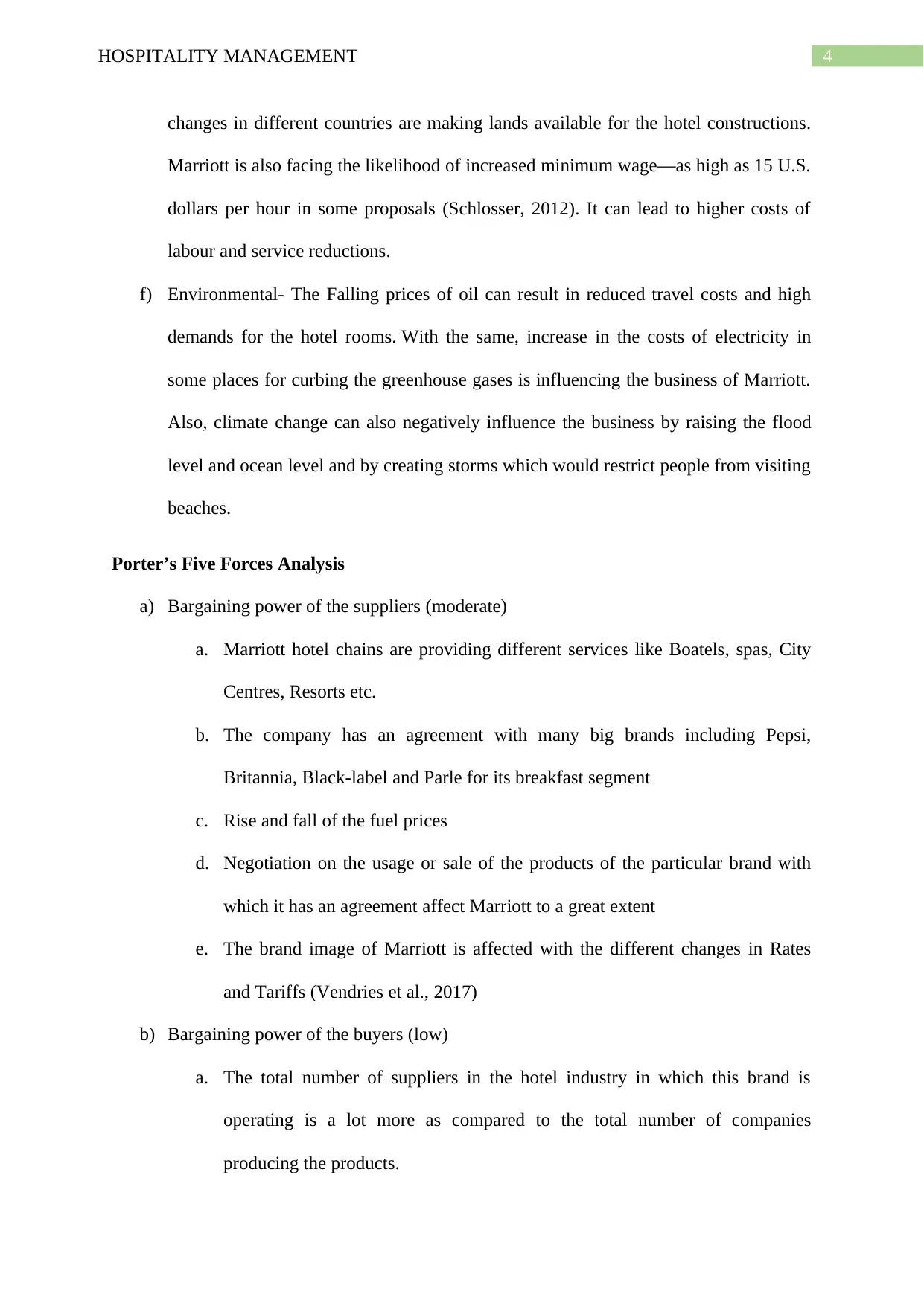
4HOSPITALITY MANAGEMENT
changes in different countries are making lands available for the hotel constructions.
Marriott is also facing the likelihood of increased minimum wage—as high as 15 U.S.
dollars per hour in some proposals (Schlosser, 2012). It can lead to higher costs of
labour and service reductions.
f) Environmental- The Falling prices of oil can result in reduced travel costs and high
demands for the hotel rooms. With the same, increase in the costs of electricity in
some places for curbing the greenhouse gases is influencing the business of Marriott.
Also, climate change can also negatively influence the business by raising the flood
level and ocean level and by creating storms which would restrict people from visiting
beaches.
Porter’s Five Forces Analysis
a) Bargaining power of the suppliers (moderate)
a. Marriott hotel chains are providing different services like Boatels, spas, City
Centres, Resorts etc.
b. The company has an agreement with many big brands including Pepsi,
Britannia, Black-label and Parle for its breakfast segment
c. Rise and fall of the fuel prices
d. Negotiation on the usage or sale of the products of the particular brand with
which it has an agreement affect Marriott to a great extent
e. The brand image of Marriott is affected with the different changes in Rates
and Tariffs (Vendries et al., 2017)
b) Bargaining power of the buyers (low)
a. The total number of suppliers in the hotel industry in which this brand is
operating is a lot more as compared to the total number of companies
producing the products.
changes in different countries are making lands available for the hotel constructions.
Marriott is also facing the likelihood of increased minimum wage—as high as 15 U.S.
dollars per hour in some proposals (Schlosser, 2012). It can lead to higher costs of
labour and service reductions.
f) Environmental- The Falling prices of oil can result in reduced travel costs and high
demands for the hotel rooms. With the same, increase in the costs of electricity in
some places for curbing the greenhouse gases is influencing the business of Marriott.
Also, climate change can also negatively influence the business by raising the flood
level and ocean level and by creating storms which would restrict people from visiting
beaches.
Porter’s Five Forces Analysis
a) Bargaining power of the suppliers (moderate)
a. Marriott hotel chains are providing different services like Boatels, spas, City
Centres, Resorts etc.
b. The company has an agreement with many big brands including Pepsi,
Britannia, Black-label and Parle for its breakfast segment
c. Rise and fall of the fuel prices
d. Negotiation on the usage or sale of the products of the particular brand with
which it has an agreement affect Marriott to a great extent
e. The brand image of Marriott is affected with the different changes in Rates
and Tariffs (Vendries et al., 2017)
b) Bargaining power of the buyers (low)
a. The total number of suppliers in the hotel industry in which this brand is
operating is a lot more as compared to the total number of companies
producing the products.
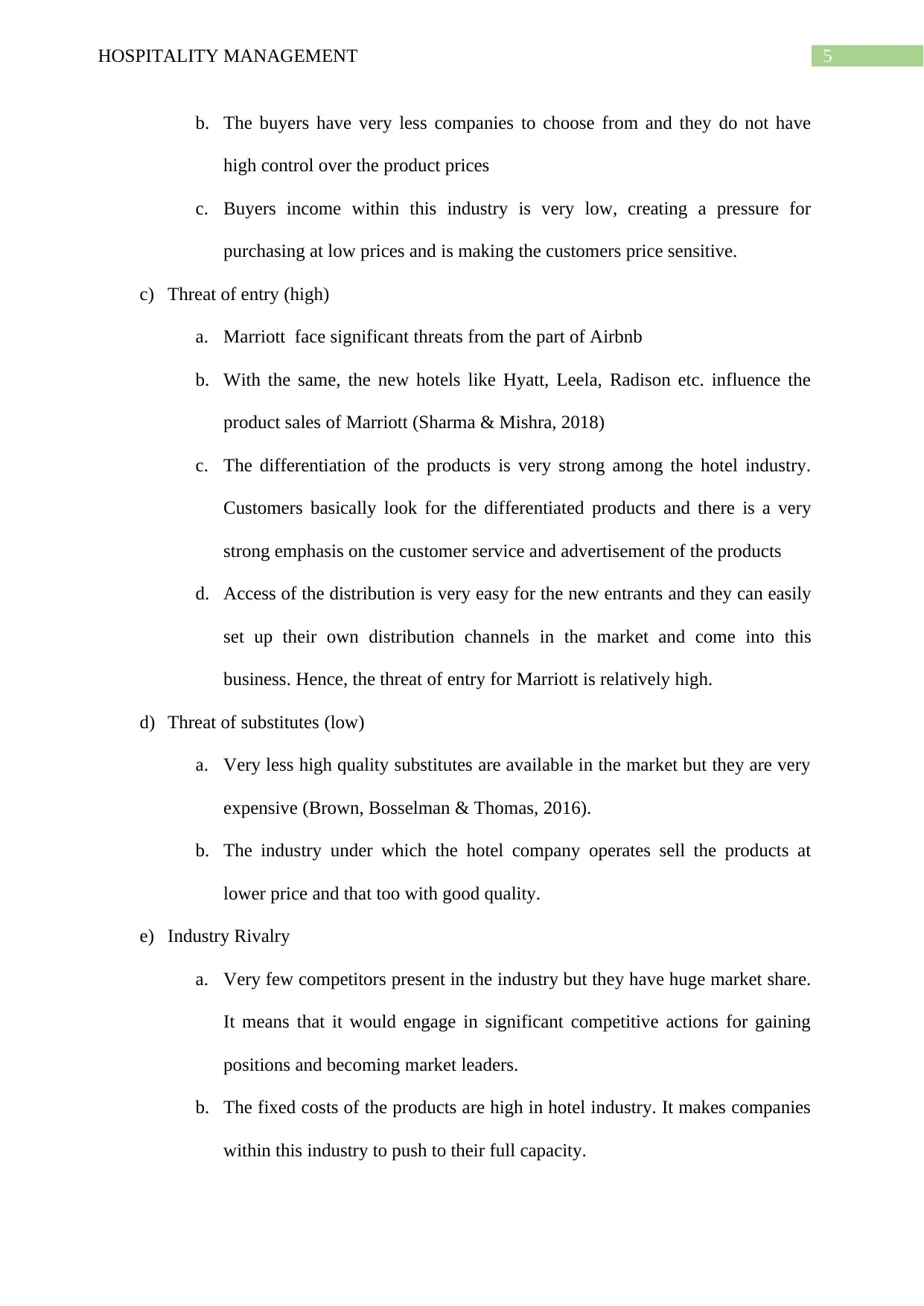
5HOSPITALITY MANAGEMENT
b. The buyers have very less companies to choose from and they do not have
high control over the product prices
c. Buyers income within this industry is very low, creating a pressure for
purchasing at low prices and is making the customers price sensitive.
c) Threat of entry (high)
a. Marriott face significant threats from the part of Airbnb
b. With the same, the new hotels like Hyatt, Leela, Radison etc. influence the
product sales of Marriott (Sharma & Mishra, 2018)
c. The differentiation of the products is very strong among the hotel industry.
Customers basically look for the differentiated products and there is a very
strong emphasis on the customer service and advertisement of the products
d. Access of the distribution is very easy for the new entrants and they can easily
set up their own distribution channels in the market and come into this
business. Hence, the threat of entry for Marriott is relatively high.
d) Threat of substitutes (low)
a. Very less high quality substitutes are available in the market but they are very
expensive (Brown, Bosselman & Thomas, 2016).
b. The industry under which the hotel company operates sell the products at
lower price and that too with good quality.
e) Industry Rivalry
a. Very few competitors present in the industry but they have huge market share.
It means that it would engage in significant competitive actions for gaining
positions and becoming market leaders.
b. The fixed costs of the products are high in hotel industry. It makes companies
within this industry to push to their full capacity.
b. The buyers have very less companies to choose from and they do not have
high control over the product prices
c. Buyers income within this industry is very low, creating a pressure for
purchasing at low prices and is making the customers price sensitive.
c) Threat of entry (high)
a. Marriott face significant threats from the part of Airbnb
b. With the same, the new hotels like Hyatt, Leela, Radison etc. influence the
product sales of Marriott (Sharma & Mishra, 2018)
c. The differentiation of the products is very strong among the hotel industry.
Customers basically look for the differentiated products and there is a very
strong emphasis on the customer service and advertisement of the products
d. Access of the distribution is very easy for the new entrants and they can easily
set up their own distribution channels in the market and come into this
business. Hence, the threat of entry for Marriott is relatively high.
d) Threat of substitutes (low)
a. Very less high quality substitutes are available in the market but they are very
expensive (Brown, Bosselman & Thomas, 2016).
b. The industry under which the hotel company operates sell the products at
lower price and that too with good quality.
e) Industry Rivalry
a. Very few competitors present in the industry but they have huge market share.
It means that it would engage in significant competitive actions for gaining
positions and becoming market leaders.
b. The fixed costs of the products are high in hotel industry. It makes companies
within this industry to push to their full capacity.
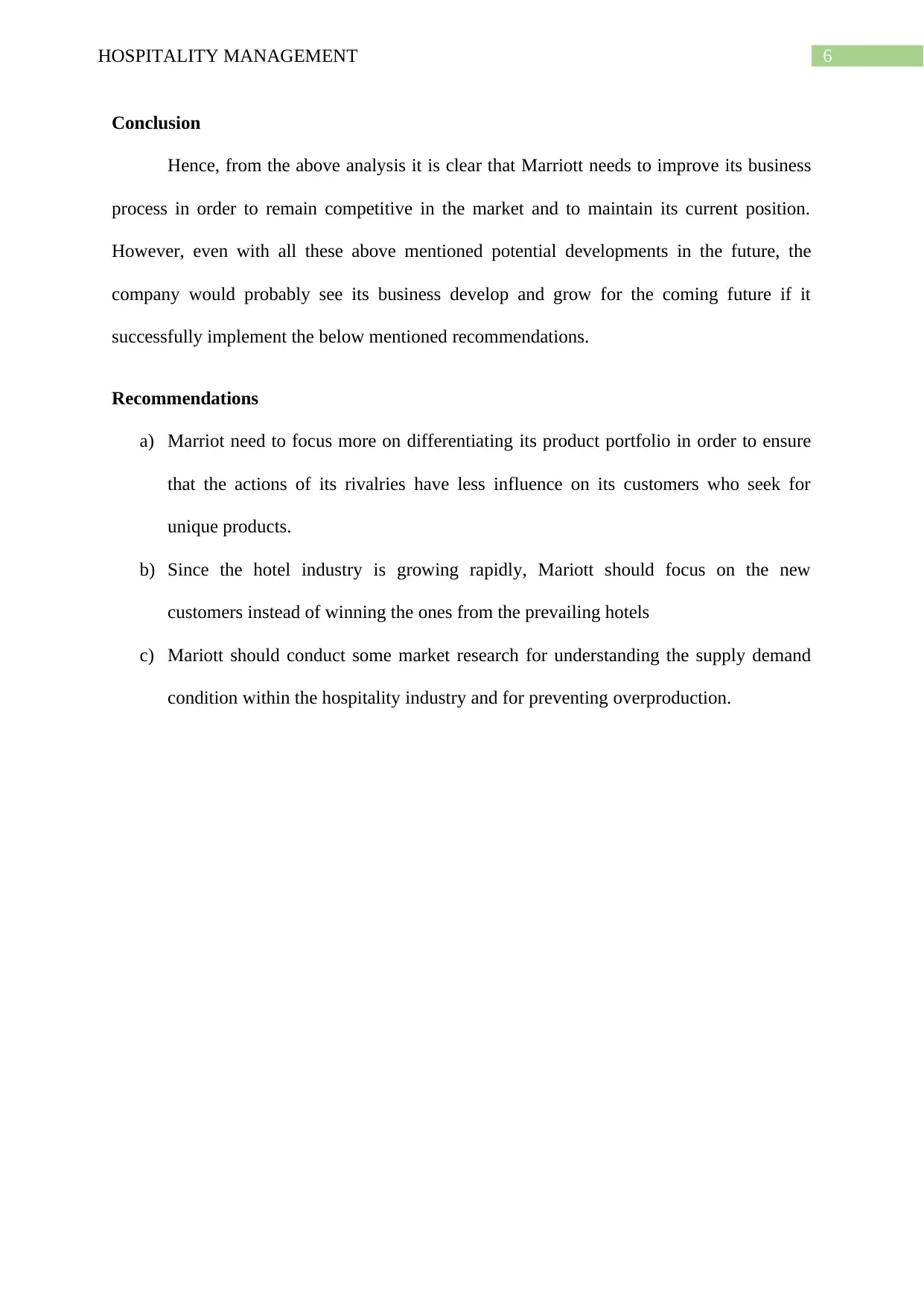
6HOSPITALITY MANAGEMENT
Conclusion
Hence, from the above analysis it is clear that Marriott needs to improve its business
process in order to remain competitive in the market and to maintain its current position.
However, even with all these above mentioned potential developments in the future, the
company would probably see its business develop and grow for the coming future if it
successfully implement the below mentioned recommendations.
Recommendations
a) Marriot need to focus more on differentiating its product portfolio in order to ensure
that the actions of its rivalries have less influence on its customers who seek for
unique products.
b) Since the hotel industry is growing rapidly, Mariott should focus on the new
customers instead of winning the ones from the prevailing hotels
c) Mariott should conduct some market research for understanding the supply demand
condition within the hospitality industry and for preventing overproduction.
Conclusion
Hence, from the above analysis it is clear that Marriott needs to improve its business
process in order to remain competitive in the market and to maintain its current position.
However, even with all these above mentioned potential developments in the future, the
company would probably see its business develop and grow for the coming future if it
successfully implement the below mentioned recommendations.
Recommendations
a) Marriot need to focus more on differentiating its product portfolio in order to ensure
that the actions of its rivalries have less influence on its customers who seek for
unique products.
b) Since the hotel industry is growing rapidly, Mariott should focus on the new
customers instead of winning the ones from the prevailing hotels
c) Mariott should conduct some market research for understanding the supply demand
condition within the hospitality industry and for preventing overproduction.
Paraphrase This Document
Need a fresh take? Get an instant paraphrase of this document with our AI Paraphraser
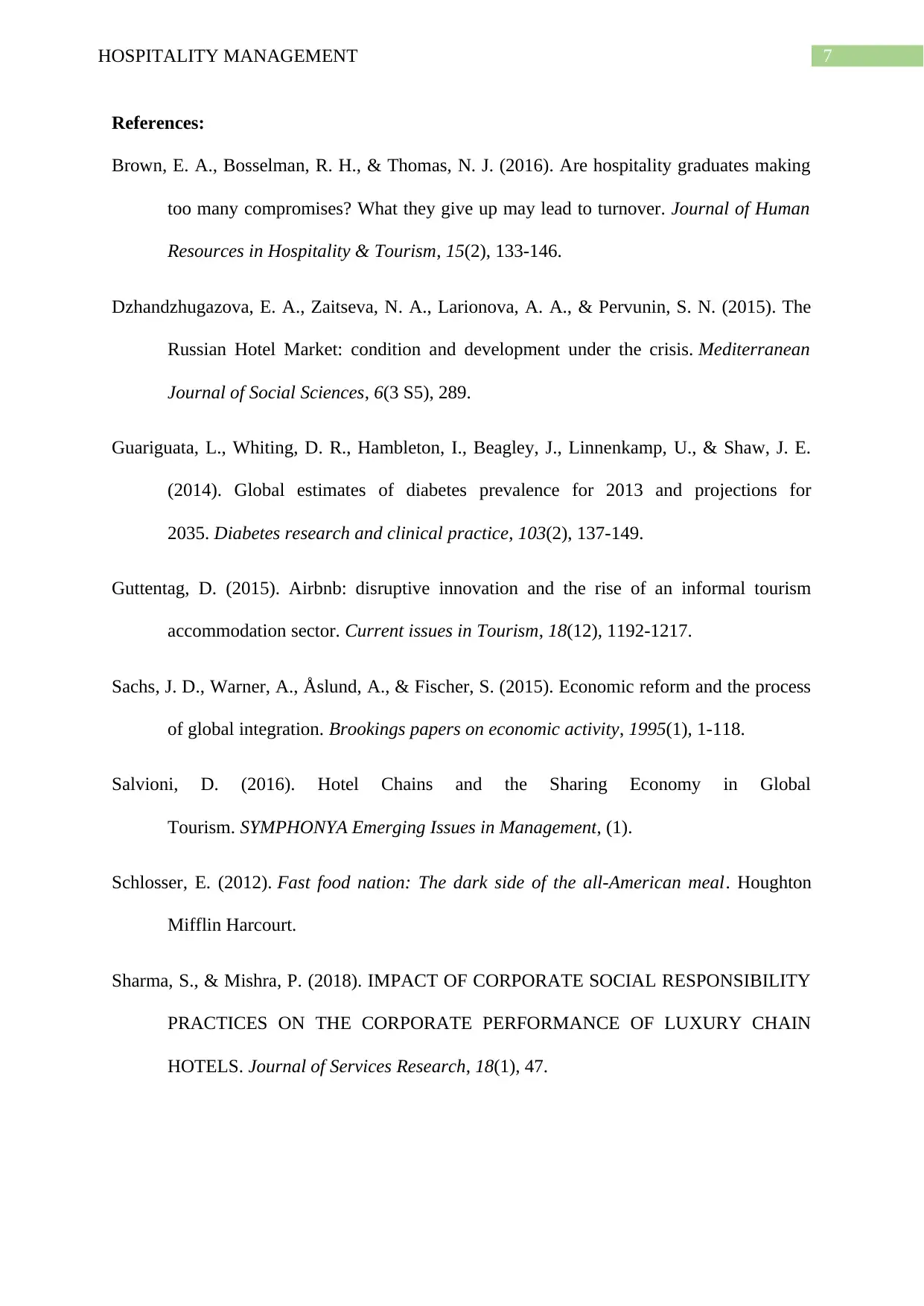
7HOSPITALITY MANAGEMENT
References:
Brown, E. A., Bosselman, R. H., & Thomas, N. J. (2016). Are hospitality graduates making
too many compromises? What they give up may lead to turnover. Journal of Human
Resources in Hospitality & Tourism, 15(2), 133-146.
Dzhandzhugazova, E. A., Zaitseva, N. A., Larionova, A. A., & Pervunin, S. N. (2015). The
Russian Hotel Market: condition and development under the crisis. Mediterranean
Journal of Social Sciences, 6(3 S5), 289.
Guariguata, L., Whiting, D. R., Hambleton, I., Beagley, J., Linnenkamp, U., & Shaw, J. E.
(2014). Global estimates of diabetes prevalence for 2013 and projections for
2035. Diabetes research and clinical practice, 103(2), 137-149.
Guttentag, D. (2015). Airbnb: disruptive innovation and the rise of an informal tourism
accommodation sector. Current issues in Tourism, 18(12), 1192-1217.
Sachs, J. D., Warner, A., Åslund, A., & Fischer, S. (2015). Economic reform and the process
of global integration. Brookings papers on economic activity, 1995(1), 1-118.
Salvioni, D. (2016). Hotel Chains and the Sharing Economy in Global
Tourism. SYMPHONYA Emerging Issues in Management, (1).
Schlosser, E. (2012). Fast food nation: The dark side of the all-American meal. Houghton
Mifflin Harcourt.
Sharma, S., & Mishra, P. (2018). IMPACT OF CORPORATE SOCIAL RESPONSIBILITY
PRACTICES ON THE CORPORATE PERFORMANCE OF LUXURY CHAIN
HOTELS. Journal of Services Research, 18(1), 47.
References:
Brown, E. A., Bosselman, R. H., & Thomas, N. J. (2016). Are hospitality graduates making
too many compromises? What they give up may lead to turnover. Journal of Human
Resources in Hospitality & Tourism, 15(2), 133-146.
Dzhandzhugazova, E. A., Zaitseva, N. A., Larionova, A. A., & Pervunin, S. N. (2015). The
Russian Hotel Market: condition and development under the crisis. Mediterranean
Journal of Social Sciences, 6(3 S5), 289.
Guariguata, L., Whiting, D. R., Hambleton, I., Beagley, J., Linnenkamp, U., & Shaw, J. E.
(2014). Global estimates of diabetes prevalence for 2013 and projections for
2035. Diabetes research and clinical practice, 103(2), 137-149.
Guttentag, D. (2015). Airbnb: disruptive innovation and the rise of an informal tourism
accommodation sector. Current issues in Tourism, 18(12), 1192-1217.
Sachs, J. D., Warner, A., Åslund, A., & Fischer, S. (2015). Economic reform and the process
of global integration. Brookings papers on economic activity, 1995(1), 1-118.
Salvioni, D. (2016). Hotel Chains and the Sharing Economy in Global
Tourism. SYMPHONYA Emerging Issues in Management, (1).
Schlosser, E. (2012). Fast food nation: The dark side of the all-American meal. Houghton
Mifflin Harcourt.
Sharma, S., & Mishra, P. (2018). IMPACT OF CORPORATE SOCIAL RESPONSIBILITY
PRACTICES ON THE CORPORATE PERFORMANCE OF LUXURY CHAIN
HOTELS. Journal of Services Research, 18(1), 47.
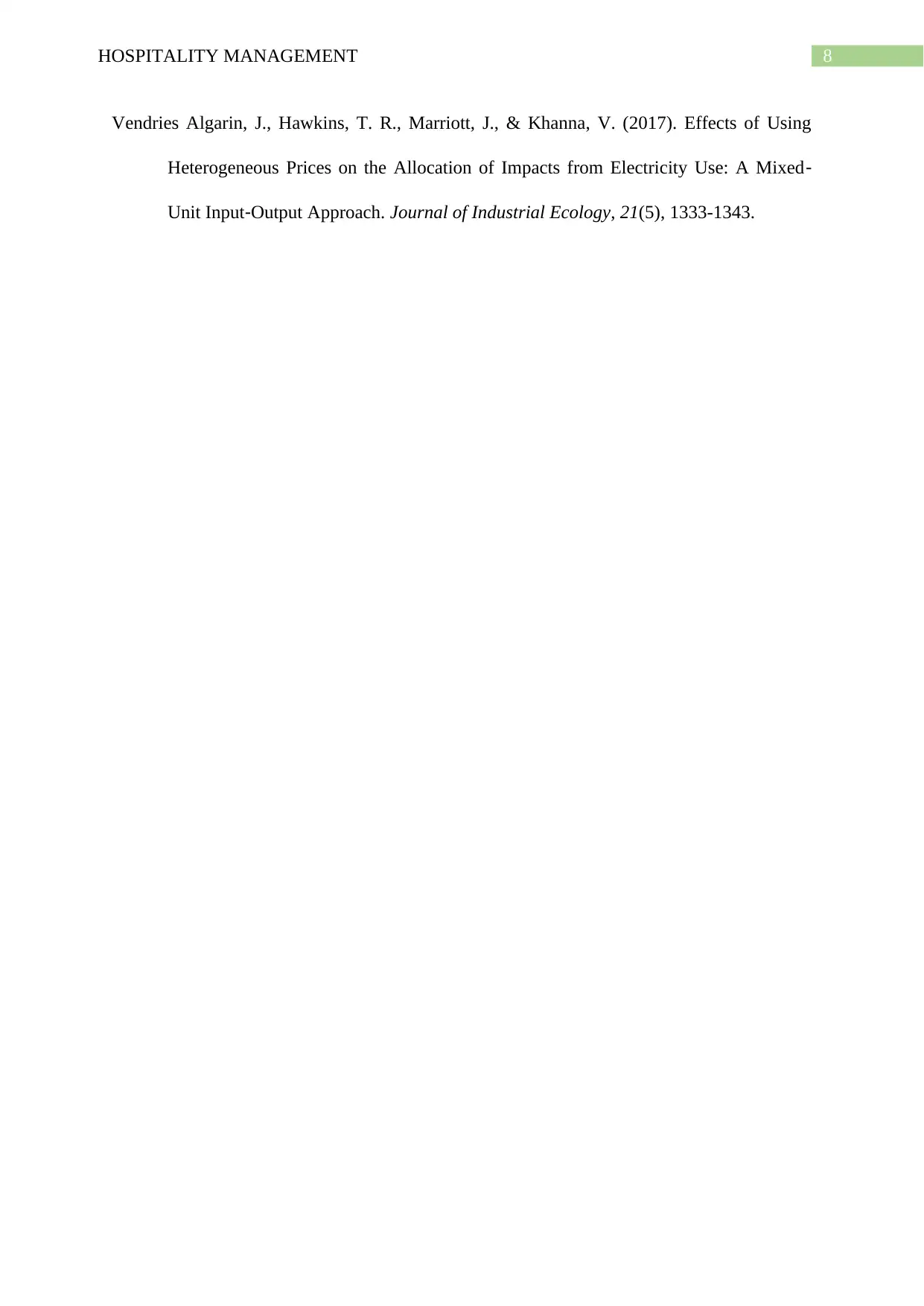
8HOSPITALITY MANAGEMENT
Vendries Algarin, J., Hawkins, T. R., Marriott, J., & Khanna, V. (2017). Effects of Using
Heterogeneous Prices on the Allocation of Impacts from Electricity Use: A Mixed‐
Unit Input‐Output Approach. Journal of Industrial Ecology, 21(5), 1333-1343.
Vendries Algarin, J., Hawkins, T. R., Marriott, J., & Khanna, V. (2017). Effects of Using
Heterogeneous Prices on the Allocation of Impacts from Electricity Use: A Mixed‐
Unit Input‐Output Approach. Journal of Industrial Ecology, 21(5), 1333-1343.
1 out of 9
![[object Object]](/_next/static/media/star-bottom.7253800d.svg)




